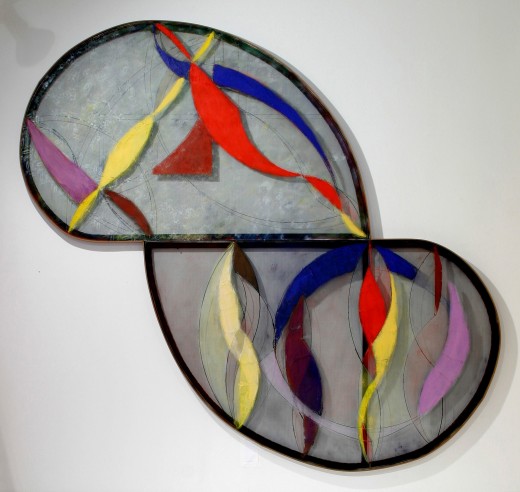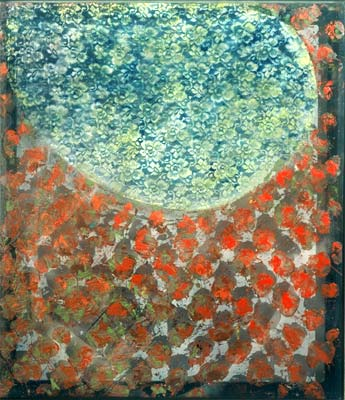Between his birth in Conehatta, Mississippi in 1933 and 1946, Joe Overstreet’s family moved five times before finally settling in Berkeley, California. In 1951 he graduated from Oakland Technical High School, joined the Merchant Marines, and working part time from 1951 through 1958, traveled to the Far East, Europe, and South America. He briefly worked as an animator at the Walt Disney Studios during the mid 1950’s.
Overstreet began his art studies in 1951 at Contra Costa College and in 1953 and 1954 studied at the California School of Fine Arts. During the early 1950’s he established a base on Grant Avenue in San Francisco, near the studio of Sargent Johnson who became very influential in his thinking. He participated in the North Beach Beat scene, and during this time Overstreet had solo exhibitions at Cousin Jimbo’s Bop City, the Bagel Shop, Vesuvio’s and Connie Smith’s Tea Room. But Overstreet was developing an interest in West Coast abstraction, and he also saw the excitement of New York painting.
So in 1958 along with his friend, poet Bob Kaufman, he moved to New York to set up his studio in the City. Overstreet credits his “real art education and development” from his talks with many artists in the Cedar Street Bar. He became friendly with DeKooning and established relationships with Romare Bearden, and Hale Woodruff. In 1962 Overstreet moved to a studio on Jefferson Street in a loft upstairs over the great jazz musician, Eric Dolphy. Then Overstreet moved to the artists’ community along the Bowery, where he spent the following fifteen years.
In his Bowery studio, he began to reconsider African art and its place in the history of art. He was already grounded in the tradition. Sargent Johnson was an important mentor for Overstreet inspiring his work ethic, intellectual tenacity and Africanist centered position. Hale Woodruff encouraged his use of African elements, and Woodruff was also able to move between figuration and abstraction. These alliances aided Overstreet in reconciling his own interests in cultural information as indicated in his early shaped canvases such as The Boat of Ra and North Star.
 The Basket Makers, 2003, Oil, stainless steel wire cloth, 92″ x 97″
The Basket Makers, 2003, Oil, stainless steel wire cloth, 92″ x 97″
During the mid 1960’s, Overstreet became involved in Civil Rights activities. He organized exhibitions and projects that created opportunities for Black artists. Overstreet worked with Amiri Baraka, the founder of the Black Arts Repertory Theatre and School as Art Director. Larry Rivers saw Overstreet’s 1963 painting The New Jemima; a Menil Foundation commission enabled him to produce a large scale version that Rivers included in the exhibit Some American History. During this period of civil rights activism, Overstreet participated in many solo and group exhibitions in New York and California. His work developed from the shaped canvases to canvas works without a stretcher that were suspended in space by ropes. These works were influenced by the tents and portable housing methods used by nomadic people.
From 1970 through 1973 Overstreet returned to California and taught studio courses at University of California at Hayward. On his return to New York in 1974, Overstreet, Corrine Jennings and writer, Samuel C. Floyd established Kenkeleba House in the East Village. Overstreet’s art production continues unabated and his work travels to Boston, to Taiwan, to Amherst and Cleveland. He created the Storyville paintings that exemplify his use of narrative and his connection to music and Jazz in particular. These paintings have been shown in New York, New Jersey; St. Louis and Atlanta. Between 1982 and 1987, he returned to the Bay Area when he received a commission to produce a seventy-five-panel work of neon and Cor-ten steel at San Francisco International Airport.
Overstreet’s studio work was often based on travels, to Martha’s Vineyard during 1984 to visit the Wampanoags, to the Alhambra, Spain to visit Moorish sites on the Iberian Peninsula., and on walks around his Lower Eastside neighborhood. Overstreet visited Tuskegee Institute, where he renewed his connection to George Washington Carver as scientist, teacher, and painter and maker of pigments. He commemorates Carver with new structures in his paintings. During a trip to Senegal for the Dakar Biennale of 1992, Overstreet visited the Slave Castle at Gorée Island. When he returned to New York he immediately embarked on a Door of No Return series of large stretched canvas paintings. These works produced over nearly two years allowed Overstreet to make full use of his interest in paint texture, and the tenets of sacred geometry.
Of his paintings he says, “My paintings don’t let the onlooker glance over them, but rather take them deeply into them and let them out – many times by different routes. These trips are taken sometimes subtly and sometimes suddenly. I want my paintings to have an eye-catching ‘melody’ to them – where the viewer can see patterns with changes in color, design and space. When the viewer is away from the paintings, they will get flashes of the paintings that linger in the mind like that of a tune or melody of a song that catches up on people’s ear and mind.”
The 1999 solo exhibition at Dartmouth College revealed paintings rich with surface texture. These works led to the Silver Screens exhibited in 2001 and Meridian Fields in 2003 that illustrate Overstreet’s interest in transparency has led him to paint on steel wire cloth. Since 2003 Overstreet’s work has been included in many important survey and traveling group exhibitions. In his career he has exhibited in more than 25 solo shows.
For 35 years Overstreet has organized exhibitions for mid-career and emerging artists, and retrospectives for those left out of mainstream history. His dedication to art, artists and the community at large is manifest through his contributions of his own work, and the opportunities Kenkeleba House and the Wilmer Jennings Gallery provide artists.
In 2009, a two-part interview and several images were published in the Hearing Eye: Jazz and Blues Influences in African American Visual Art. Joe Overstreet was recently interviewed for the Archives of American Art, Smithsonian Institution.




[…] East Second Street. Building owned by artist Joe Overstreet, originally a ballroom based on the design of Webster […]
[…] morning I went to the nursing home for art class and then on my way home, I ran into my neighbor Joe Overstreet standing outside his building. Joe is a very accomplished artist who has lived in the East […]